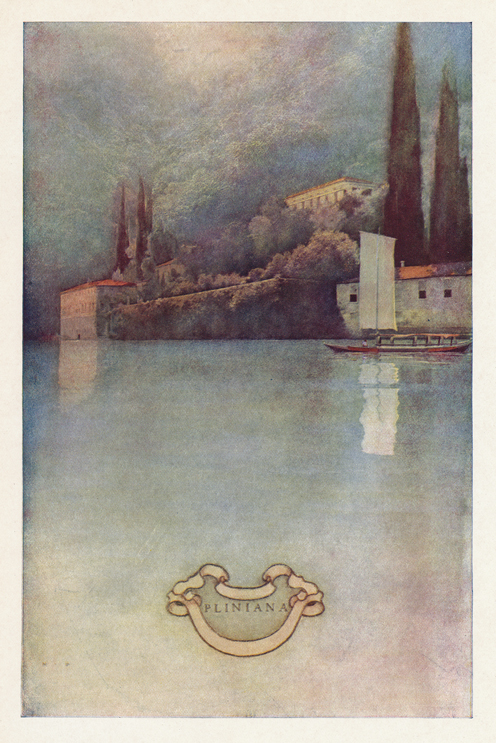Maxfield Parrish
Maxfield Parrish
Maxfield Parrish Signed Autographed Personal Note Card
Beautiful bold signature on his personal 3.5″ x 5′ Windsor, Vermont note card. Lightly toned, mounting traces to verso, very good condition. Together with antique print, over 100 years old, of Parrish’s Villa Pliniana as commissioned by the novelist Edith Wharton for her book “Italian Villas and Their Gardens,” published in 1904. Her description of the Villa Pliniana on Lake Como is one of the most effusive, appealing to any Italophile:
Just across [Lake Como], in the deep shade of the wooded cliffs beneath the Pizzo di Torno, lies another villa still more steeped in the Italian garden-magic. This is the Villa Pliniana, built in 1570 by the Count Anguissola of Piacenza, and now the property of the Trotti family of Milan. The place takes its name from an intermittent spring in the court, which is supposed to be the one described by Pliny in one of his letters; and it is farther celebrated as being the coolest villa on Como. It lies on a small bay on the east side of the lake, and faces due north, so that, while the villas of Cernobbio are bathed in sunlight, a deep green shade envelops it. The house stands on a narrow ledge, its foundations projecting into the lake, and its back built against the almost vertical wooded cliff which protects it from the southern sun. Down this cliff pours a foaming mountain torrent from the Val di Calore, just beneath the peak of Torno; and this torrent the architect of the Villa Pliniana has captured in its descent to the lake and carried through the central apartment of the villa.
The effect produced is unlike anything else, even in the wonderland of Italian gardens. The two wings of the house, a plain and somewhat melancholy-looking structure, are joined by an open arcaded room, against the back wall of which the torrent pours down, over stonework tremulous with moss and ferns, gushing out gain beneath the balustrade of the loggia, where it makes a great semicircle of glittering whiteness in the dark-green waters of the lake. The old house is saturated with the freshness and drenched with the flying spray of the caged torrent. The bare vaulted rooms reverberate with it, the stone floors are green with its dampness, the air quivers with its cool incessant rush. The contrast of this dusky dripping loggia, on its perpetually shaded bay, with the blazing blue waters of the lake and their sun-steeped western shores, is one of the most wonderful effects in sensation that the Italian villa-art has ever devised.
The architect, not satisfied with diverting a part of the torrent to cool his house, has led the rest in a fall down the cliff immediately adjoining the villa, and has designed winding paths through the woods from which one may look down on the bright rush of the waters.
MAXFIELD PARRISH (1870-1966) American painter and illustrator, best known as an illustrator for advertisements, magazines, and such books as Mother Goose in Prose and The Golden Age. Parrish’s art features dazzlingly luminous colors; the color Parrish blue was named in acknowledgement. He achieved the results by means of a technique called glazing where bright layers of oil color separated by varnish are applied alternately over a base rendering (Parrish usually used a blue and white monochromatic under-painting).
He would build-up the depth in his paintings by photographing, enlarging, projecting and tracing half or full size objects or figures. Parrish then cut out and placed the images on his canvas, covering them with thick, but clear, layers of glaze. The result is realism of elegiac vivacity. His work achieves a unique three-dimensional appearance, which does not translate well to coffee table books.



